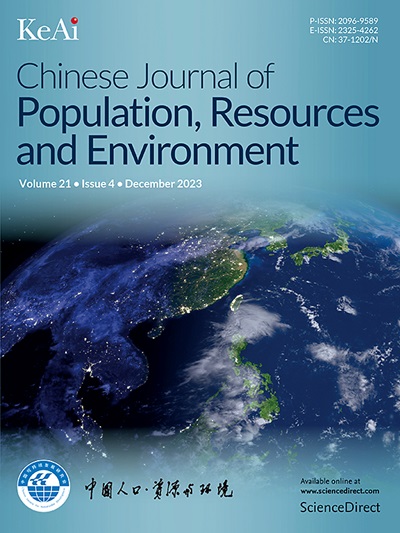Comprehensive index of extreme climate risk in China and urban sustainable development
IF 4.8
4区 环境科学与生态学
Q2 ENVIRONMENTAL STUDIES
Chinese Journal of Population Resources and Environment
Pub Date : 2025-03-01
DOI:10.1016/j.cjpre.2025.01.006
引用次数: 0
Abstract
Climate change severely challenges our ecosystem and society, affecting urban residents’ socioeconomic activities. Thus, assessing severe weather risk is crucial for evaluating urban sustainability; understanding trends, causes, and impacts on socioeconomic development; and supporting the United Nations Sustainable Development Goal (SDG) 13. Using meteorological data from 1980 to 2020, we investigate five disaster-causing severe weather events in China and construct a comprehensive index of extreme climate risk (CIECR) at the county, city, province, and national levels. The CIECR can identify high-risk regions and primary severe weather events and provide early warnings. We empirically test the impact of extreme climate risks on agricultural production, industrial structure, and labor employment. The results show high risks in Xinjiang, northern Inner Mongolia, and southern regions, with high temperatures, low temperatures, and high winds as the leading risks. At the national level, the extreme climate risk fluctuates, indicating climate warming. While risks reduce agricultural production and employment, they promote modern agriculture, industrial production, and urbanization. The novelty of the study lies in its development of the county-level CIECR, which can capture heterogeneity characteristics and provide microdata support for urban climate change research and efforts toward SDG 13. This study aids in mitigating climate risks; responding to climate change; and comprehensively analyzing the causes, trends, and impacts of extreme climate risks.
中国极端气候风险综合指数与城市可持续发展
气候变化严重挑战生态系统和社会,影响城市居民的社会经济活动。因此,评估恶劣天气风险对于评估城市可持续性至关重要;了解社会经济发展的趋势、原因和影响;支持联合国可持续发展目标(SDG)本文利用1980 ~ 2020年的气象资料,对中国5次特大灾害性天气事件进行了调查,构建了县、市、省和国家4个层面的极端气候风险综合指数(CIECR)。CIECR可以识别高风险地区和主要恶劣天气事件,并提供早期预警。实证检验了极端气候风险对农业生产、产业结构和劳动力就业的影响。结果表明,新疆、内蒙古北部和南部地区风险较高,高温、低温和大风是主要风险。在国家层面,极端气候风险波动,表明气候变暖。风险在减少农业生产和就业的同时,也促进了现代农业、工业生产和城市化。该研究的新颖之处在于其县级CIECR的发展,可以捕捉城市气候变化的异质性特征,为城市气候变化研究和实现可持续发展目标13提供微观数据支持。这项研究有助于减轻气候风险;应对气候变化;全面分析极端气候风险的成因、趋势和影响。
本文章由计算机程序翻译,如有差异,请以英文原文为准。
求助全文
约1分钟内获得全文
求助全文
来源期刊

Chinese Journal of Population Resources and Environment
ENVIRONMENTAL STUDIES-
CiteScore
4.30
自引率
1.10%
发文量
791
审稿时长
79 days
期刊介绍:
The Chinese Journal of Population, Resources and Environment (CJPRE) is a peer-reviewed international academic journal that publishes original research in the fields of economic, population, resource, and environment studies as they relate to sustainable development. The journal aims to address and evaluate theoretical frameworks, capability building initiatives, strategic goals, ethical values, empirical research, methodologies, and techniques in the field. CJPRE began publication in 1992 and is sponsored by the Chinese Society for Sustainable Development (CSSD), the Research Center for Sustainable Development of Shandong Province, the Administrative Center for China's Agenda 21 (ACCA21), and Shandong Normal University. The Chinese title of the journal was inscribed by the former Chinese leader, Mr. Deng Xiaoping. Initially focused on China's advances in sustainable development, CJPRE now also highlights global developments from both developed and developing countries.
 求助内容:
求助内容: 应助结果提醒方式:
应助结果提醒方式:


